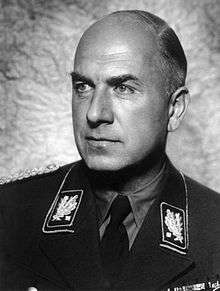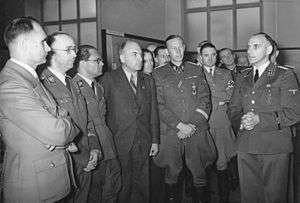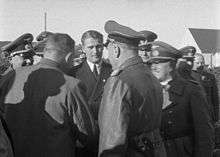Fritz Todt
Fritz Todt (4 September 1891 – 8 February 1942), was a German construction engineer and senior Nazi, who rose from the position of "Inspector General for German Roadways", where he directed the construction of the German Autobahns (Reichsautobahnen), to become the Reich Minister for Armaments and Ammunition. From that position he directed the entire German wartime military economy. At the beginning of World War II he initiated what Hitler named Organisation Todt, a military-engineering company, which supplied industry with forced labor and administered construction of the Nazi concentration camps in the late phase of Nazi Germany. Todt died in a mysterious aircraft crash in 1942.
Fritz Todt | |
|---|---|
 Reich Minister Todt March 1940 | |
| Reich Minister for Armaments and Ammunition | |
| In office 17 March 1940 – 8 February 1942 | |
| Leader | Adolf Hitler (Führer) |
| Preceded by | Position established |
| Succeeded by | Albert Speer |
| Personal details | |
| Born | 4 September 1891 Pforzheim, Grand Duchy of Baden, German Empire |
| Died | 8 February 1942 (aged 50) near Rastenburg, Province of East Prussia Nazi Germany |
| Resting place | Invalids' Cemetery, Berlin |
| Political party | Nazi Party |
| Parents | Emil Todt (father) Elise Unterecker (mother) |
| Education | Construction engineering |
| Alma mater | Technical University of Munich and Karlsruhe Institute of Technology |
| Profession | Civil engineer |
| Known for | Chief of Organisation Todt |
| Cabinet | Hitler Cabinet |
| Civilian awards | German Order |
| Military service | |
| Allegiance | |
| Branch/service | Luftstreitkräfte |
| Years of service | 1914–1918 |
| Rank | Lieutenant of the reserve |
| Battles/wars | World War I |
| Military awards | Iron Cross |
Biography
Early life and education
Todt was born in Pforzheim in the Grand Duchy of Baden, today's Baden-Württemberg to Emil Todt (1861–1909) and his wife Elise née Unterecker (1869–1935). His father owned a small ring factory. During 1910, he volunteered for one-year military service. From 1911 to 1914, Todt studied engineering at Technical University of Munich and at Karlsruhe Institute of Technology, graduating with a Diplom degree in construction engineering from the latter.[1]
During World War I, he served initially with the infantry and then as front line reconnaissance observer within the Luftstreitkräfte (the German Air Forces – DLSK), winning the Iron Cross. After the war he resumed his studies, graduating during 1920.[1]
Career
During 1921 he initially worked on waterpower stations for the Grün & Bilfinger AG, Mannheim company and, later during 1921, the civil engineering company Sager & Woerner and worked there until 1933.[1] On 5 January 1922, he joined the Nationalsozialistische Deutsche Arbeiterpartei (NSDAP), or "Nazi Party". In 1931, he became an Oberführer (senior Colonel) in the Sturmabteilung (SA), which was then commanded by Ernst Röhm. During 1932, Todt completed his thesis at Technical University of Munich "Fehlerquellen beim Bau von Landstraßendecken aus Teer und Asphalt" – "Sources of defects in the construction of tarmac and asphalt road surfaces" and became a Doctor of Engineering (Dr.-Ing.).[1]

In July 1933, five months after Hitler became Reichskanzler, Todt was appointed "Inspector General for German Roadways" (Generalinspektor für das deutsche Straßenwesen). This public authority (Oberste Reichsbehörde) was privileged to be outside the hierarchy of Reich Ministries; Todt was subordinated directly to Hitler.[1] Alan S. Milward characterized this phase as follows: "His personal views on business questions and, what was more important, the success of the motorway project kept Todt in the inner circle of the Führer. At the same time, his deliberate pose as a technical expert, as a man without interest in internal power struggles, saved him from the adversaries of the more important party leaders for a long time. "[2]:44 He was given the task of organizing a new construction company for the motorways (Reichsautobahnen).[3] He edited the journal Die Strasse, which was a publication of his agency from 1934 to 1942.[4] For his work on the autobahnen, Todt was recognized with the German National Prize for Art and Science by Hitler, next to Ernst Heinkel, Ferdinand Porsche and Willy Messerschmitt.[1] Hitler donated the award during 1937, devised as a replacement for the Nobel Prize, which Hitler forbade Germans from accepting starting during 1936.
In 1938, he became Leiter des Hauptamts für Technik in der Reichsleitung der NSDAP ("Director of the Head Office for Engineering in the National Directorate of the NSDAP") and during December Generalbevollmächtigter für die Regelung der Bauwirtschaft ("General Commissioner for the Regulation of the Construction Industry"). At the beginning of World War II in Europe, he was also appointed to the rank of Generalmajor of the Luftwaffe.[1] During May 1938, he initiated the Organisation Todt (OT), joining together government firms, private companies and the Reichsarbeitsdienst (Reich Labour Service).[1] OT used up to 800,000 forced laborers (Zwangsarbeiter) from countries Germany occupied during World War II.[1] Todt was responsible for the construction of the "West Wall" (commonly named the "Siegfried Line" in English-speaking countries) to defend the Reich territory.

On 17 March 1940, Todt was appointed Reichsminister für Bewaffnung und Munition ("Minister for Armaments and Munitions") which meant he managed the entire military economy.[1]
After the invasion of the USSR during June 1941, Todt was appointed to manage the restoration of the infrastructure there. At the end of July 1941 he was named Inspector General for water and energy. During that year, he became increasingly distant from the commanders of the Wehrmacht and in particular, from Reichsmarschall Hermann Göring, the Oberbefehlshaber der Luftwaffe (Commander-in-chief of the Luftwaffe).[1] After an inspection tour of the Eastern Front, Todt complained to Hitler that without better equipment and supplies for the armed forces it would be better to end the war with the Soviet Union.[1] Hitler rejected such an assessment and continued the offensive against the Soviets.
Personal life
Todt was married and had three daughters and one son.
On the occasion of his 50th birthday in 1941, he founded the Dr. Fritz Todt Foundation. The goal of the organisation was to promote young talents of technicians, especially young people from poor families by a training subsidy.
Death
On 8 February 1942, soon after takeoff from the Wolfsschanze ("Wolf's Lair") airfield near Rastenburg in East Prussia, Todt's aircraft crashed.[1] He was buried in the Invalids' Cemetery in the Scharnhorst-Strasse in Berlin. Posthumously, he became the first recipient of the newly-created Deutscher Orden ("German Order"),[1] the highest award the Nazi Party could bestow on a person for "duties of the highest order to the state and party".
It has been suggested that Todt was the victim of an assassination orchestrated by Hitler, but that has never been confirmed.[5][6] Todt's successor as Reichsminister was Albert Speer, whom Hitler awarded an Org.Todt ring during May 1943. Speer mentioned the Reich Air Ministry enquiry into the airplane accident, which he said ended with the sentence: "The possibility of sabotage is ruled out. Further measures are therefore neither requisite nor intended". Speer, who was present and had declined to ride on the same flight, thought that the wording was "curious".[7]:279
Legacy

On 8 February 1944, the second anniversary of Todt's death, Hitler awarded the Dr.-Fritz-Todt-Preis as a Badge of Honor of the Nazi Party for "Innovative accomplishments, which are of great importance for the Volk community because of the improvement of their weapons, ammunition and military equipment, and the saving of labor, raw materials and energy". The Badge of Honor came with a material prize and a certificate, was awarded as a medal made of gold, silver, or steel. The Golden Award of Honor was presented by Hitler in person upon proposal by the responsible Gauleiter, upon the joint proposal of Robert Ley, the director of the corresponding Deutsche Arbeitsfront and NSDAP leaders, and the director of the "Main office for Technology in the NSDAP", Albert Speer.[8]
Major awards
- 1918 Iron Cross
- 1937 Werner-von-Siemens-Ring
- 1938 Deutscher Nationalpreis für Kunst und Wissenschaft[9]
- 1939 Großkreuz des Order of the Crown of Italy[10]
- 1942 Deutscher Orden.
See also
| Wikiquote has quotations related to: Fritz Todt |
| Wikimedia Commons has media related to Fritz Todt. |
| Wikisource has original text related to this article: |
References
- Stefan Kuhn Fritz Todt Deutsches Historisches Museum online, 17. September 2015 (German)
- Alan S. Milward: Fritz Todt als Minister für Bewaffnung und Munition. In: Vierteljahrshefte für Zeitgeschichte 14, 1966, Heft 1, p. 40–58).
- Stephenson, Charles (2006). The Channel Islands 1941–45: Hitler's Impregnable Fortress. Osprey Publishing. p. 16. ISBN 978-1-84176-921-9.
- R. Vahrenkamp Register for "Die Strasse" University of Kassel
- Kirkham, James F.; Levy, Sheldon G.; Crotty, William J. (1969). Assassination and Political Violence. 8. Washington, D.C.: National Commission on the Causes and Prevention of Violence. p. 493. ISBN 0-87754-281-3. OCLC 19993393.
- Taylor, Blaine (16 December 2018). "The Mysterious Death of Dr. Fritz Todt, Nazi Engineer". Warfare History Network. Retrieved 16 March 2020.
- Albert Speer's autobiography: Erinnerungen. Ullstein, Berlin 1969, ISBN 3-549-07184-1.
- Peter Koblank.Best of Koblank Die Göring-Speer-Verordnung. Arbeitnehmererfindungsrecht im Dritten Reich / Dr.-Fritz-Todt-Preis. EUREKA impulse 12/2012, p. 2.
- Todt, Fritz ww2awards.com, STIWOT, n.d. accessed 14 July 2017.
- Der deutsche Baumeister 12/1939.
Further reading
- Kroener, Bernhard R., Rolf-Dieter Muller, and Hans Umbreit, eds. Germany and the Second World War: Volume 5: Organization and Mobilization of the German Sphere of Power. Part I: Wartime Administration, Economy, and Manpower Resources, 1939-1941 Oxford University Press, (2000)
- Overy, Richard J. (1988). "Mobilization for Total War in Germany 1939-1941."". English Historical Review: 613–639. JSTOR 572694.
- Taylor, Blaine. Hitler's Engineers: Fritz Todt and Albert Speer-Master Builders of the Third Reich (Casemate Publishers, 2010)
- Busch, Andreas: Die Geschichte des Autobahnbaus in Deutschland bis 1945. Rockstuhl, Bad Langensalza 2002, ISBN 3-936030-40-5.
- Schönleben, Eduard: Fritz Todt, der Mensch, der Ingenieur, der Nationalsozialist. Ein Bericht über Leben und Werk. Gerhard Stalling, Oldenburg 1943.
- Schütz, Erhard, Eckhard Gruber: Mythos Reichsautobahn. 2. Auflage. Links, Berlin 2000, ISBN 3-86153-117-8.
- Franz W. Seidler: Fritz Todt. Baumeister des Dritten Reiches. Ullstein, Frankfurt am Main/Berlin 1988, ISBN 3-548-33095-9.419 pp.
- Adam Tooze: Ökonomie der Zerstörung. Die Geschichte der Wirtschaft im Nationalsozialismus. Siedler, München 2006 (German 2007), ISBN 978-3-88680-857-1. New edition: Schriftenreihe der Bundeszentrale für politische Bildung, vol. 663, ISBN 978-3-89331-822-3. Wieder: Pantheon, München 2008, ISBN 978-3-570-55056-4.
External links
- Tribute to Fritz Todt. Story RG-60.3910, Film ID: 2691. Deutsche Wochenschau, February 1942 (in German). Duration 8:35 min. Steven Spielberg Film and Video Archive, USHMM. Funeral of Fritz Todt at 01:05:12.
- Newspaper clippings about Fritz Todt in the 20th Century Press Archives of the ZBW